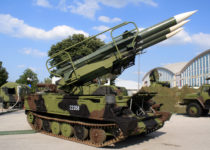Where Does The Balakot Episode Fit In India’s Evolving Strategy Towards Pakistan?

At around 5:40 am on February 26, 2019, Maj. Gen. Asif Ghafoor Posted a Tweet about LOC violation by Indian Air Force in the area around Balakot town.
The coming weeks would see a crazy train of back and forth claims and counter claims about whether or not the Indian Mirages really hit the terror training camp in Balakot, whether or not the Pakistani air strike package intentionally hit a field instead of the Indian military instillation next to it, whether or not the Indian Mig-21 flown by Wing Commander Abhinandan shot down a Pakistani F-16 etc.
What seems to be largely missing from the public discourse, is what thought process led the Modi government to take this route and what are its long term ramifications going to be. The air strike at Balakot is just a part of a new approach that India seems to be taking towards Pakistan, and this is my own take on this aspect.
The rivalry between India and Pakistan is as old as the nations themselves. It started with the 1947 war, and saw two more conventional wars, one in 1965 and the other in 1971. But something happened in the 1980s that changed the way in which Pakistan approached the rivalry. In that decade, the USSR invaded Pakistan’s northern neighbor Afghanistan. And as if on cue, the US took the side of the mujahideen, the partisans resisting the Soviet forces and the Afghan communist government friendly to them.
These mujahideen consisted of myriad armed groups headed by warlords who did not always see each other eye to eye. So when the Soviets finally left, these different groups started fighting among themselves, plunging an already war torn Afghanistan into a civil war. And the power vacuum created as a result was filled by the Taliban, who took over much of Afghanistan, including its capital Kabul, and ruled it until they were ousted in 2001 by the US led international coalition.
The defeat of Soviet forces by the mujahideen reinforced the perception of guerrilla warfare being an effective tool against a far stronger adversary, a perception that was already strong after the successful guerrilla campaign by the Vietcong against the American forces in Vietnam war. Meanwhile, the vast amount of funding and assistance given to the mujahideen had also vastly strengthened the Jihadist groups based in Pakistan, which already enjoyed support from the Pakistani state because of Gen. Zia Ul Haq’s pro Islamist policies. Pakistan then decided to use the same strategy of guerrilla warfare and the same jihadists that she had used against the Soviets, against India in Kashmir.
Since then, Pakistan has used guerrilla warfare strategy that was originally formulated by Che Guevara, the Argentine Marxist-Leninist revolutionary. Che Guevara believed that in order to have an upper hand over a far more powerful adversary, the guerrilla group must keep the adversary pinned down in static formations. If the adversary fortifies himself in a fixed spot instead of searching for you, you get the freedom of mobility and get the time to plan an execute attacks on him. And the more you attack him, the more he fortifies himself into fixed locations, giving you more and more freedom to move around and attack.
The guerrilla group can discourage the adversary from going on the offensive by making themselves hard to find and attack, by hiding among civilians, in forests, or in a friendly neighboring country. This is the strategy that Vietcong used against US forces in Vietnam, with the blessings of North Vietnam, the Mujahadeen used against the Soviets with the blessings of US and Pakistan, and the jihadists have been using against India with the blessings of Pakistan. Indian authorities, until now, had been on the defensive. Their response to a terror attack being to further fortify military sites, and increase vigilance and surveillance in civilian targets like malls, airports and railway stations.
In fact, some politicians actually questioned why the soldiers who were targeted in Pulwama attack were not being transported by air instead of buses. This is exactly the defensive mindset that the terror groups strive to cultivate in their enemy. Transporting the soldiers by air would certainly make them safer. But it will also be a sign to the public, to the enemy, and to the international community, that Indian military is intimidated by the terrorists, and it would also make it easier for the terrorists to operate on the ground, with no soldiers on the road.
But for a conventional adversary, breaking out of this defensive strategy and going on the offensive is anything but easy. The US tried to break out of it in Vietnam by taking the war into North Vietnam through operation rolling thunder. But this campaign failed because the full might of the US military could not be brought to bear down on North Vietnam for fear of escalation, with the communist allies of North Vietnam, China and USSR, likely to enter the war in response.
The Soviets too tried to break out of their defensive positions in major Afghan cities, by taking the war to the mujahideen, bombing the villages and countryside where they were believed to be sheltering. But they too, decided against taking the war into Pakistan and attack the Mujahideen and Jehadist sanctuaries there, for fear of escalation.
India too, finds it difficult to break out of its defensive stance and go on the offensive, for similar reasons. The Jihadists enjoy sanctuary in a nuclear armed neighbor that is hostile to India, which India hesitates to attack for fear of escalation. How can India go on the offensive, imposing costs on the Jihadists and on the Pakistani state, without escalating the conflict to dangerous levels, and without failing like the US in Vietnam and the Soviets in Afghanistan?
Well aware of this dilemma faced by India, Pakistan has worked hard to reinforce it by constantly bringing up the prospect of nuclear war. In addition to having no policy prohibiting a nuclear first strike, Pakistan has sought to lower the nuclear threshold by fielding low yield, tactical nuclear weapons that can theoretically be used even in response to a limited, low intensity, conventional campaign by India. The use of these tactical nuclear weapons is even more justifiable when Pakistani forces plan to use them against Indian forces on Pakistan’s own soil.
This lowering of nuclear threshold has further squeezed the options India has for taking the war against terror into Pakistan. So much so that there was no retaliation by India after the 2008 Mumbai terror attacks that killed more than 160 people, and during Kargil conflict, the Indian forces had clear orders not to cross the line of control.
India’s current administration under prime minister Narendra Modi, however, seeks to change that. The first instance of India’s new approach was seen in the response to the 2016 terror attack by four Jaish-e-Mohmmad fighters on an Indian Army brigade headquarters in Uri, which had resulted in deaths of 19 Indian soldiers and all 4 terrorists. On September 28, just eleven days after this attack, Indian soldiers from the 4th and 9th battalions of Indian Army’s Parachute Regiment attacked multiple terror launch pads on the Pakistani side of LOC.
The second instance was seen in response to the pulwama suicide bombing that had killed 40 Indian soldiers. India seems to have chosen to carry out an air strike in this case, instead of infiltrating Pakistani territory with special forces, for multiple reasons. Firstly, the target in this case was well inside Pakistan. Secondly, the Pakistanis were anticipating a raid similar to the one in response to Uri attack this time too, so they were likely prepared for it.
I must be remembered, however, that this new stance of India towards provocation is not Pakistan specific. A year before the surgical strike in response to the Uri attack, a cross border raid against NSCN-K (National Socialist Council of Nagaland) militants was carried out inside Myanmar by personal from Indian Air Force and 21 PARA Special Forces. The government of Myanmar was kept in the loop about the raid though, unlike the raid in Pakistan.
Gauging Pakistan’s Response
Regardless of the method of retaliation, however, the intention behind this new approach is clear. These strikes put Pakistan in a dilemma. They are clearly not intense enough to warrant a nuclear response. Not even one involving low yield tactical nukes. And yet Pakistan must respond in some way to save face. This leaves two options for Pakistan. Either mount a proportional, conventional retaliation in response every time a strike like this happens, risking escalation, or work on preventing the terror attacks that trigger these strikes in the first place, by cooperating with India.
To gauge which of these two paths Pakistan is more likely to take and how often, we need to understand the internal politics of Pakistan. While officially a democracy, Pakistan has always had two competing centers of power- the civilian, elected leadership, and the Pakistan Army, which has frequently carried out coups and ruled Pakistan as a dictatorship for around half of Pakistan’s history as an independent nation. Since its creation in 1947, there have been four successful coups and at least four unsuccessful coup attempts in Pakistan.
One of the clearest examples of the tussle between the army and civilian leadership in Pakistan can be seen in the relationship between former prime minister Nawaz Sharif and former president Pervez Musharraf. Before the Kargil conflict started in 1999, prime minister Nawaz Sharif had no inkling that Gen. Pervez Musharraf had ordered Pakistani troops to occupy Indian posts in the Kargil district of India.
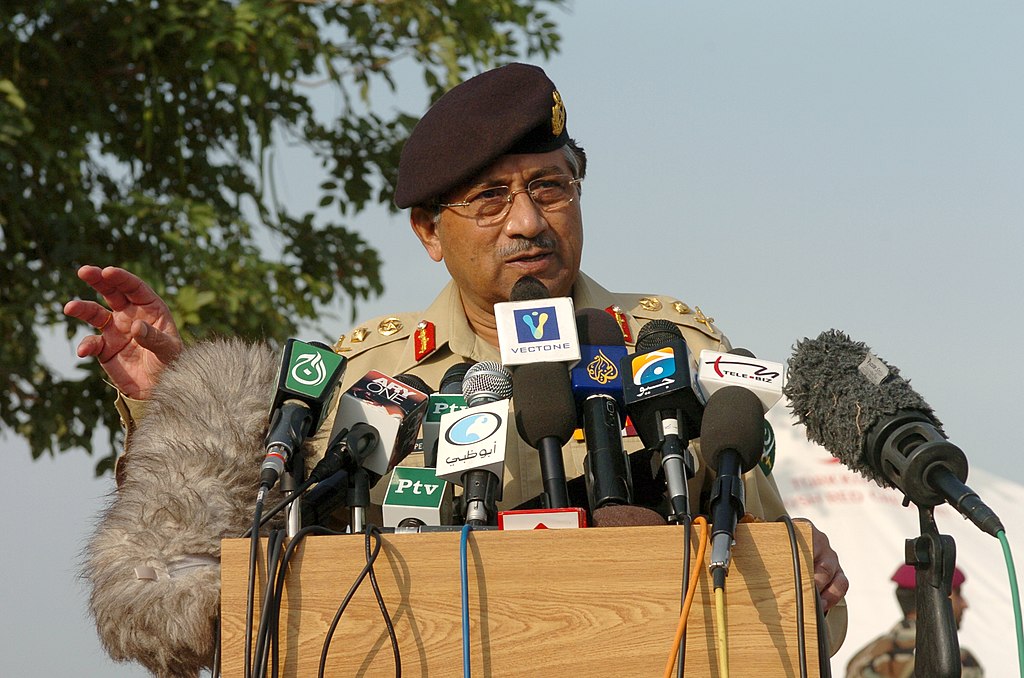
In fact, earlier that same year, Sharif had hosted Indian prime minister Atal Bihari Vajpayee on his visit to Pakistan. And during Kargil conflict, Sharif seemed to have no inkling that the Pakistan army had started positioning the country’s nuclear tipped missiles to be ready to launch them against targets in India. He seemed genuinely surprised when he was informed about this by the US. And later that same year, Sharif was overthrown by Musharraf in a coup when he tried to dismiss him.
Historically, Pakistan’s civilian leadership has been far more interested in improving relations with India than the Pakistan army. So how Pakistan responds to India’s aggressiveness depends a lot on which of these two power centers- the civilian leadership or the army- will have a greater say in Pakistan’s policies in future. In fact, since the Balakot episode, Pakistani government has already shared information about a possible terror plot with India in at least one instance.
Another factor that will determine Pakistan’s response to India’s new stance is how capable its own counter terror forces are, as any attempt by Pakistan to clamp down on terror groups is sure to invite prompt and large scale retaliation from the terrorists.
This was evident from how after Musharraf ordered the storming of the Red Mosque in Islamabad in 2007 to arrest the hardliners inside it, the Tehrik-e-Taliban Pakistan initiated a deadly campaign of suicide bombings and conventional raids across Pakistan, that went on till 2009, resulting in deaths of thousands of people, including former prime minister Benazir Bhutto, terror attack on a Sri Lankan cricket team during an international match resulting in halting of international cricket tournaments in Pakistan for many years, and a raid on a Pakistani naval base in Karachi resulting in 18 deaths and destruction of 2 P3C Orion aircraft.
Due to experience gained from this chapter, its likely that Pakistan has significantly improved its counter terror capabilities since. Nonetheless, this aggressive stance of terror groups means that India will need to provide a lot of incentive to Pakistan for it to clamp down on terror groups.
Pakistan’s Evolving Force Posture
Satellite images suggest that Pakistan has taken up extensive overhauling of its entire defense infrastructure. The image below for example, shows new aircraft shelters being built at the PAF air base at Peshawar. These hardened aircraft shelters are situated very close to the runway, and an ammunition storage, likely housing air to air weaponry, is being constructed right next to them.
These shelters are called alert role hardened aircraft shelters. They enable fighters to quickly arm and take off to confront hostile aircraft, spending minimum possible time on the tarmac. This could make it easier for PAF to react promptly to a future aerial intrusion by India, and could be in response to the PAF’s inability to react to the Indian Mirage 2000s in time when they entered Pakistani airspace to carry out the Balakot strike.
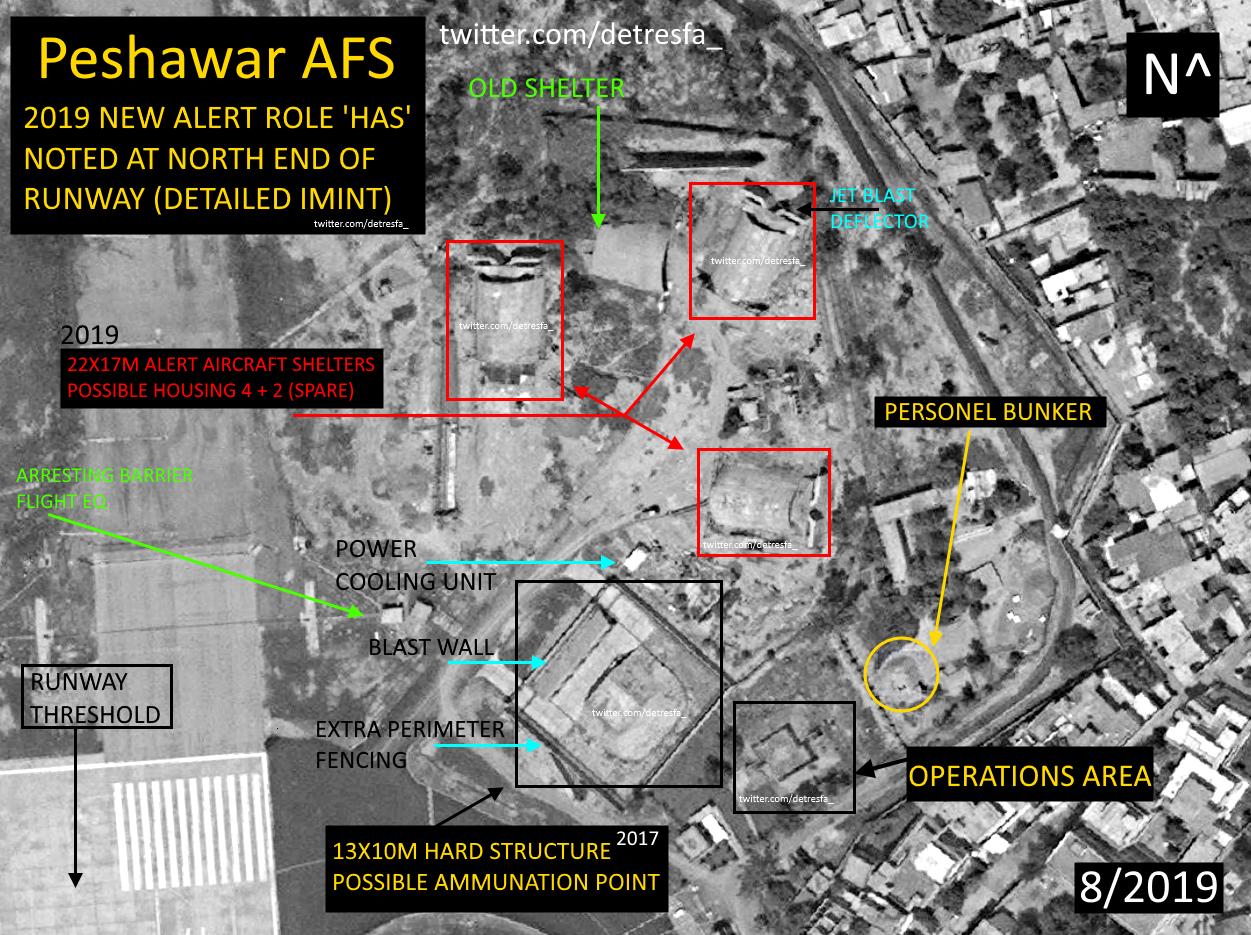
Following image shows major expansion work going on at Skardu air base, situated around 200 km from both Leh and Srinagar. Additional, underground fuel stores are being constructed, which indicates that more aircraft might be hosted here in future. A second, parallel runway is being constructed to enable aircraft to become quickly airborne. Additional ammunition depots are also being constructed. Ammunition depots next to aircraft shelters usually indicate that they contain air to air weaponry to quickly arm the aircraft nearby, for promptly responding to aerial intrusions.
These new ammunition depots however, are being constructed not next to the aircraft shelters, but away from them. This indicates that they could house precision guided munitions. Strike missions are usually planned well in advance, and hence the munitions used in them don’t have to be situated close to the aircraft shelter. This indicates that in future this base could be used to carry out not just air defense missions, but also strike missions in Jammu and Kashmir and Ladakh.
In addition, Pakistan has installed a JY-27A CVLO radar at the Mianwali air base. This a Chinese made surveillance/guidance radar that has a detection range of 500 km and is claimed to be able to detect stealth targets. The location of this radar in Mianwali, located in North/Central Pakistan, suggests that it is meant for surveillance of most of Pakistan’s northern airspace, checking Indian air activity near the border, and also observe the air activity inside Afghanistan. The later part might help China gain information about the tactics and other details of US and other coalition aircraft as they operate in Afghanistan.

Pakistan is also securing the border with India by deploying medium range SAM systems, as can be seen from this satellite imagery showing a LY80/HQ16A system in Lahore, 30 km from the border.
This deployment of LY80/HQ16A defense system on the border is mirrored by similar deployment of Akash air defense system by Indian forces in Amritsar, just 20 km from border and less than 50 km from Lahore.
Apart from taking these immediate measures to bolster its defenses against and response to air strikes from India, Pakistan is also going ahead with efforts to become self sufficient in research, development and manufacturing capabilities in advanced weapon systems like airplanes and missiles. This is evident from expansion works going on at Pakistan’s National Defense Complex and Pakistan Aeronautical Complex at Minhas airbase.
Lessons From Balakot
Nineteenth century Prussian field Marshal Helmuth Karl Bernhard Graf von Moltke is renowned for his quote that still applies to warfare- “No plan survives contact with the enemy”. Consequently, every time you go to war, you always have something new to learn. And this is why a military’s effectiveness is decided not just by its training and firepower, but also by how battle hardened it is. Balakot episode also taught many lessons to the Indian armed forces.
Lesson 1: The radio system being used by IAF aircraft during the dogfight with Pakistani fighters the morning after Balakot was jammed by the PAF. This is believed to be the main reason behind Wing Commander Abhinandan Varthaman’s MiG-21 Bison being shot down, as he didn’t receive the order to disengage. In response, the defense ministry has cleared the proposal to install new, software defined radios on all IAF aircraft. The new radios are being supplied by Israel.
Lesson 2: In a friendly fire incident on the same day, an IAF Mi-17 was shot down by an IAF Spyder air defense system. To prevent a repeat of such incident, the Identification of Friend or Foe (IFF) technology being used by IAF needs to be upgraded, and the crew needs to be better trained.
Lesson 3: The R-77 missiles being used by IAF Su-30MKIs during the dogfight had a range of 80 km, while the AIM-120C being used by PAF F-16s had a range of 100 km. This put the IAF Sukhois on the defensive. This is the reverse of the situation during Kargil war, when the IAF Mig-29s had longer range missiles than PAF F-16s. Pakistan is also planning to buy AIM-120D, with a range of 160 km.
To mitigate this difference, India had tried to buy and integrate the 100 km range Israeli I Derby and 150 km range MBDA Meteor on its Sukhois. However, the Integration of Meteor on Sukhois could not go ahead as MBDA wasn’t ready, lest the tech secrets of this cutting edge missile are stolen by Russian engineers during its integration on Sukhois.
Integration of I Derby on Sukhois is also facing opposition from the Russians, who want India to buy their 110 km range RVV-AE missiles instead. So for now, Pakistan enjoys an advantage over India in terms of its longer range air to air missiles, and this will have to be factored in while planning a future operation.
This discrepancy will be resolved to some extent once the 36 Rafales will be inducted into the Indian Air Force, as these Rafales will carry 150 km range meteor missiles, out ranging the 100 km range AIM-120Cs of PAF F-16. Its likely that this order for 36 Rafales will be followed bysimilar orders for more Rafales in future. Because as of now, PAF has 76 F-16s in its inventory against the 36 Rafales currently bought by India, and also because Pakistan is trying to buy the 160 km range AIM-120D.
The long term solution, however, lies in the induction of 110 km range Astra missile and the indigenous SFDR (Solid Fuel Ducted Ramjet) missile being developed by DRDO. The process of induction of Astra has already started. The SFDR missile uses the same propulsion technology as the Meteor and will have a comparable range. Astra and SFDR missiles will be carried by almost all Indian combat aircraft, significantly enhancing their capabilities.
India is also developing a 400-500 km range air to air version of Brahmos supersonic cruise missile. However, this missile will most likely work against large, slow targets like AWACS aircraft, refueling tankers, bombers and cargo aircraft, and not against fighter sized targets.
Lesson 4: The need for more AWACS aircraft was also felt during the aerial fight after Balakot strike. Pakistan currently has 4 Saab 2000 and 4 Shaanxi Y-8 AWACS planes, while India has 3 Bereiv A-50EI and 3 EMB-145 Netra AWACS planes, giving Pakistan a numerical advantage in this sphere. Even though the IAF was very satisfied with the performance of its available AWACS platforms, their low number meant that the service had a hard time ensuring constant coverage of the airspace in the region.
Reports indicate that the PAF exploited the time when the Indian AWACS were switching shifts, to prevent India from detecting its retaliatory air strike package in the morning after Balakot strike. DRDO is currently developing a new AWACS system that will be mounted on the A-330 aircraft.
Lesson 5: Another shortfall exposed after Balakot episode was the fact that the frontline airbases of IAF near the international border and with Pakistan and LOC were not equipped to host Su-30MKIs, which is believed to have created difficulties in responding to the aireal retaliation by Pakistan. To address this, India already appears to be overhauling bases like the one at Adampur to hose Su-30MKIs, as can be seen in the satellite images below.
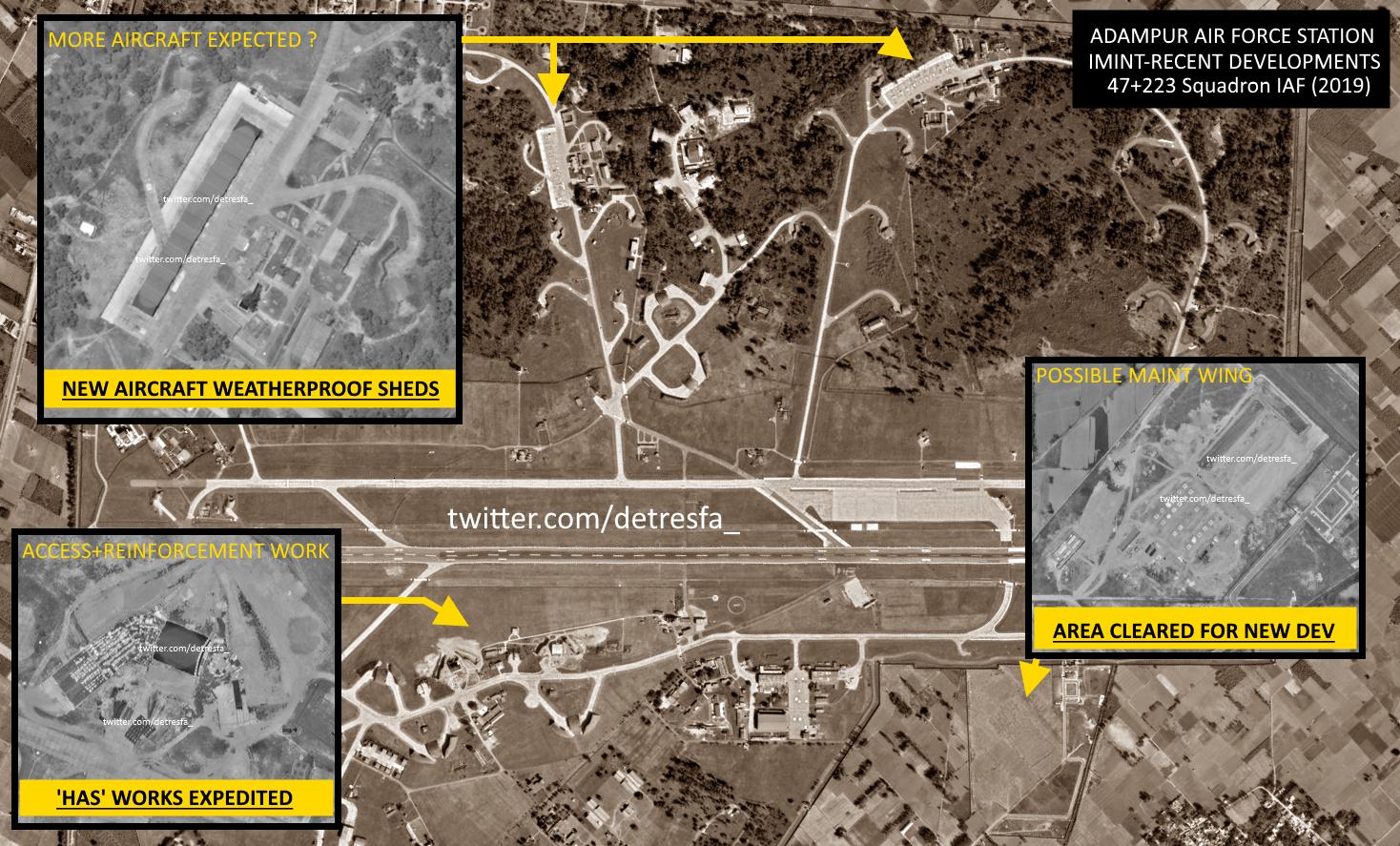
India’s Plans And Options
Let’s now look at what India’s options are to deal with cross border terrorism, given the overhauls in Pakistan’s defenses. First off, shortly after the Pulwama attack, the Indian government granted emergency purchase powers to it’s armed forces. Under these powers, all three services of the Indian military can buy whatever equipment they deem necessary within three months, at a cost of up to 42 million dollars.
These powers allow the armed forces to bypass all the tedious bureaucracy, including the Integrated financial adviser of the defense finance department. It’s basically a stopgap measure meant to quickly plug the gaps in the military’s capabilities using weapons already available in the market, even as India’s numerous domestic weapons development projects continue with their own pace.
So, while Indo-Russian Rifles Private Limited, a joint venture between India and Russia, is going to produce 670,000 AK-203 assault rifles for the Indian army, the army is also procuring 72,000 ready made assault rifles from US firm Sig Sauer. While India’s indigenous anti tank guided missile continues it’s final developmental trials pending induction, Indian army has also placed order for 240 Israeli Spike anti tank missiles.
While India’s Future Infantry Combat Vehicle (FICV) program to replace its BMPs with 3000 new vehicles continues, the army plans competitive bids in July 2020 to select and buy 198 ready infantry fighting vehicles. Who will win this bid remains to be seen. But the Kestrel IFV being jointly developed by DRDO and TATA group is a strong contender.
And while the development of Astra and SDFR missiles continues, Indian Air force has signed a deal to acquire 300 short range R-73 and 400 medium range R-77 missiles from Russia. Alongside, as the 90 km range guided rockets of Pinaka Mk2 undergo testing, Indian army has also procured 600 M982 Excalibur GPS guided projectiles that can be used in its K9 Vajra tracked howitzers and M777 ultralight howitzers.
Meanwhile, India’s various indigenous weapons development and modernization programs for army, air force and navy continue at a slow but steady pace, ranging from UCAVs, fighter jets and artillery to aircraft carriers, nuclear submarines and intercontinental missiles. Alongside continues procurement of a large number of foreign origin platforms, including assault rifles, helicopters, fighter jets, air defense systems and frigates, most of which will be locally built under Make in India program.
Artillery Strikes
So what is India’s future response to terror attacks from Pakistan going to look like based on the plans and options at is disposal? There is a spectrum of responses, differing in intensity and perceived level of escalation that India can employ, depending on requirements and situation. If the targets selected are close enough to the LOC, then cross border special forces raids (like the one in 2016) and cross border artillery strikes are options.
However, after the 2016 special forces raid in response to Uri attack, Pakistan is likely to have significantly bolstered its defenses against such raids in the border region. Hence, artillery strikes seem to be the more viable option. Here, the Excalibur projectile procured for K9 Vajra and M777 howitzers is what will immediately come in handy. And according to this report, it is already being used in minor cross LOC strikes.
However, the small number of Excalibur projectiles ordered show that like the other weapons ordered under the emergency purchase powers, Excalibur projectiles are likely meant to be a stop gap measure. In long term, the task of precisely hitting targets in the border region will be taken up by guided Pinaka Mk2 rockets. These rockets will reportedly have a range of 90 km, and were tested on 19 and 20 December 2019.
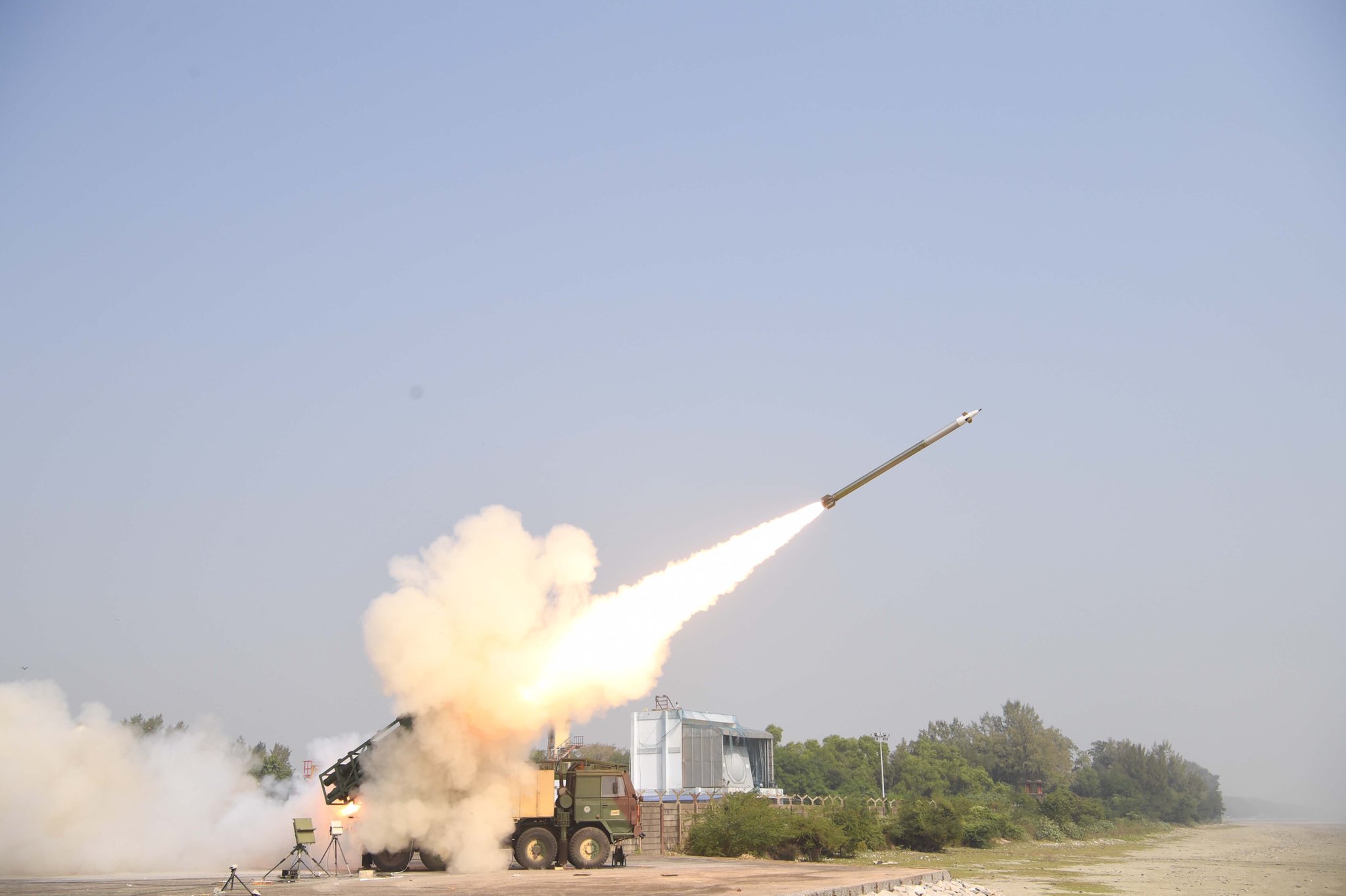
Publicly available images and videos of Pinaka Mk2 system show some interesting details. The image below shows a close up of the front portion of the Pinaka Mk2 rocket. Those tiny holes visible all over the front part of the rocket are gas nozzles, which suggests that along with its fins, the rocket will also use thrust vectoring to achieve greater accuracy.
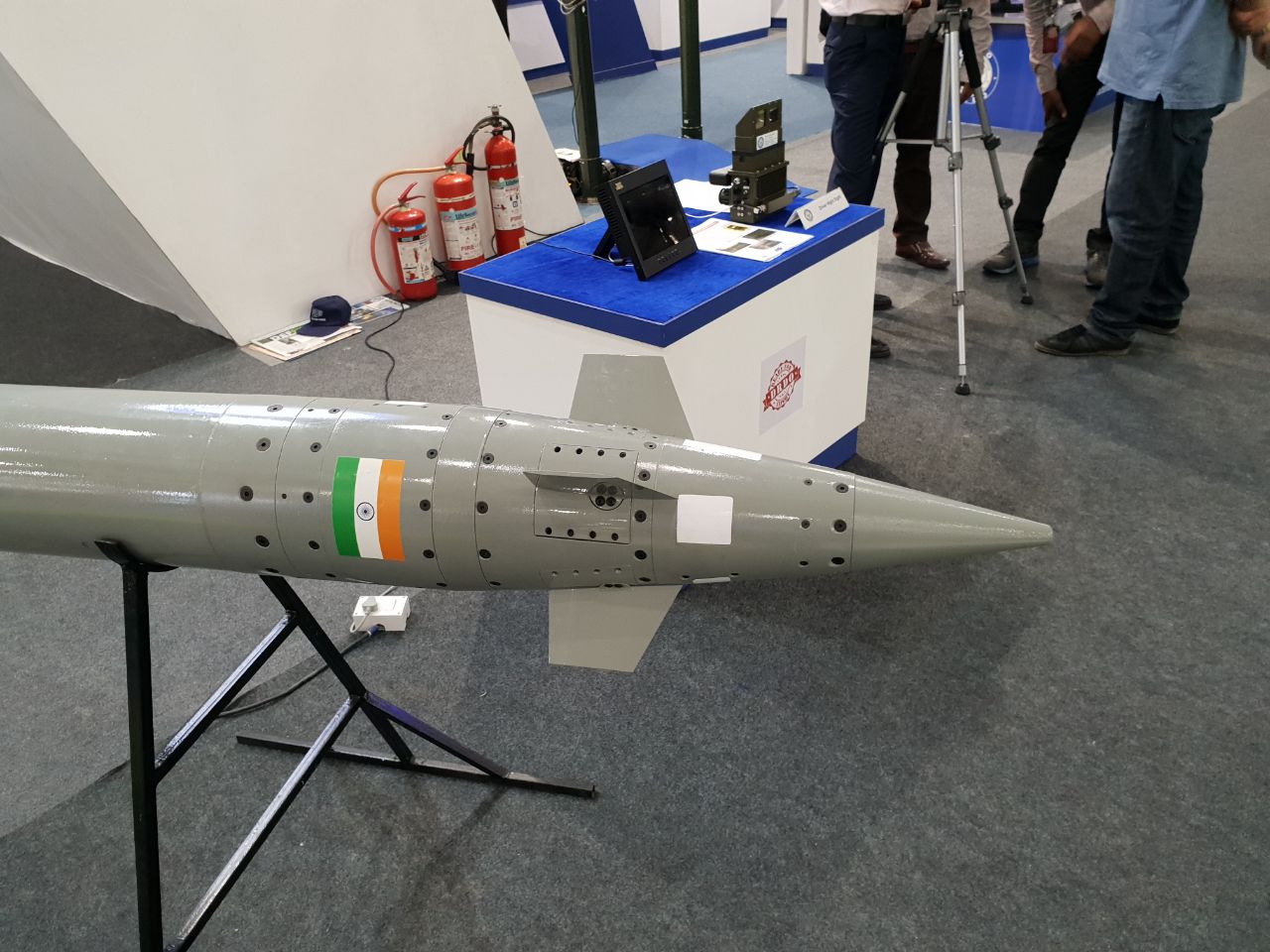
The video below shows the test launch of Pinaka Mk2. It can be seen in the beginning that the launcher has slots for 8 rockets. Pinaka Mk1 launcher on the other hand, has slots for 12 rockets based on publicly available images. This shows that the Pinaka Mk2 rocket is likely bigger in size. Which could reflect larger fuel carrying capacity for increased range.

The important thing to note is that while high profile strikes like Balakot attract the most media attention, its not realistic to use them in response to every small provocation in the border region. An attack of the scale of Pulwama wrrants a Balakot like airstrike. But airstrikes are not just seen as escalatory and provocative, they also involve extensive planning and preparation. And the regular ceasefire violations by Pakistani forces, infiltration attempts by militants, or receipt of actionable intelligence regarding an impending terror attack, with its future perpetrators in a location within striking distance of Indian artillery, do not warrant an airstrike.
To deal with these scenarios, artillery strikes and special forces raids are better options as they are less escalatory and can still get the job done. So it is these low profile artillery strikes, and not air strikes, that will be the common method of dealing with challenges in the border regions. And it is in this context that the Pinaka Mk2 system being tested could come in very handy. The image below shows the extensive areas that can be covered by its 90 km range rockets. With this range, even the camp near Balakot could be hit by Pinaka Mk2.
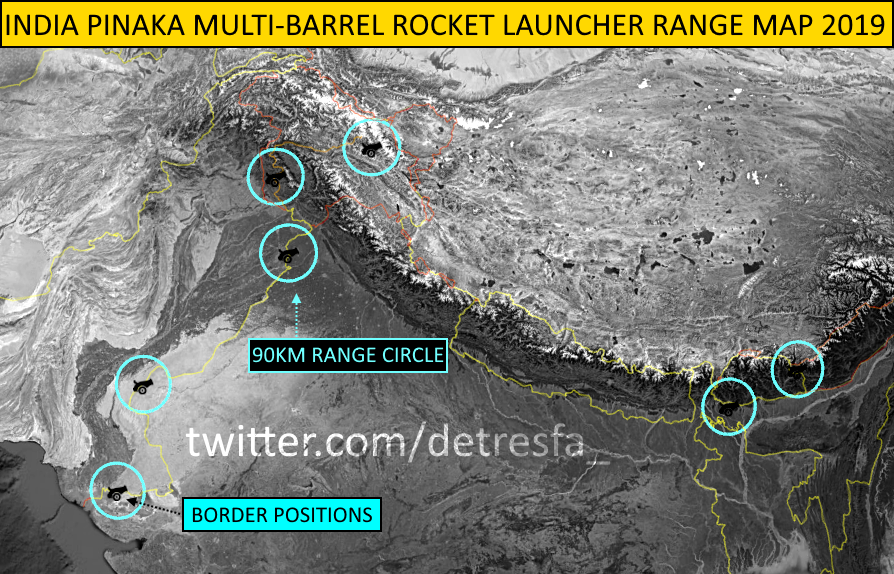
India is also developing Pinaka Mk3 with even longer range, meant as a replacement for its Smerch rocket launchers. Plus a new, 200 km range missile named Pranash is being developed, which will supposedly be a modified version of the 150 km range Prahaar missile, which itself is based on the AAD endoatmospheric interceptor of India’s ballistic missile defence system.
Air Strikes
But what options does India have if the target is beyond the range of artillery, or there is a major provocation that warrants airstrikes? Pakistan has doubtless learnt lessons from Balakot episode, as can be seen from the overhauls in it’s air defense infrastructure discussed above. These overhauls mean that in a future airstrike, Indian air force will likely need standoff weapons to stay at a safe distance from Pakistani defenses. Let’s look at the standoff weapons that India has/will have at its disposal.
At the low end comes the Smart Anti Airfield Weapon, or SAAW, being developed by DRDO. From external looks, this seems to be based on the Israeli SPICE 250 glide bomb and will have a range of 100 km. It is capable of penetrating hardened structures, and weighs just 120 Kg. Due to its small weight and size, it can be carried in large numbers by strike aircraft.
An IAF Jaguar, for example, will be able to carry up to 16 SAAWs at a time using a combination of twin rack and quad rack pylons. In fact, some reports suggest that the original plan was to use SAAW, and not SPICE 2000 in Balakot airstrike. But it was later decided to use SPICE 2000, perhaps because SAAW was not ready at that time.
After SAAW comes the SCALP EG cruise missile that will be carried by Rafale. This subsonic cruise missile has a range of around 500 km and can carry a 450 kg warhead. It can also be fitted with BROACH warhead that is capable of penetrating hardened structures. Its external features suggest that it is low observable.
At the high end of capabilities comes Brahmos. This is a Mach 3 capable cruise missile with a range of 500 km and carries a 200 kg warhead. Its high speed, low altitude flight and maneuverability make it very difficult to shoot down. And the Mach 3 speed coupled with its 3000 kg weight means that it hits its target with tremendous kinetic energy, allowing it to penetrate hardened structures and impart heavy damage.
There are indications that in future the range of Brahmos will be extended to 800 km. In fact, an 800 km range version of P-800 Oniks, the missile on which Brahmos is based, has already been tested by Russia. Brahmos can be launched from submarines, ships, road mobile launchers and Su-30MKI, and can be used against land and sea targets. A smaller, lighter version of Brahmos, called Brahmos NG is also being developed. This version will have a range of 300 km and maximum speed of Mach 3.5.
Due to its light weight and small size, Brahmos NG will be capable of being carried not just by Su-30MKI but also by Mig-29 (both air force and naval versions) and Tejas. A Su-30MKI will be able to carry up to 5 Brahmos NG missiles at a time, while Mig-29 will probably carry 2 or 3, and Tejas will carry 2 of them. Just like traditional Brahmos, Brahmos NG can be used against land as well as sea targets. But according to some reports, an air to air version of Brahmos will also be developed, to be used against large, slow aircraft like AWACS, refueling tankers, transporters and strategic bombers.

Limited Land Campaign
Finally, there is the the scenario in which an act of aggression by Pakistan is deemed so provocative that a land campaign is considered the right mode of retaliation. Such a campaign will involve large scale artillery barrages, air strikes, special forces raids, and armored formations including tanks and APCs crossing the international border. Out of all the options available to India, this will the riskiest one, as it is in this scenario that Indian forces will come dangerously close to crossing Pakistan’s nuclear threshold. At this stage, its worthwhile to understand how India’s and Pakistan’s strategies have evolved over the decades.
On 13 December 2001, militants belonging to Lashkar-e-Taiba and Jaish-e-Mohmmad attacked the Indian parliament, leading to deaths of 14 people. This was an attack considered to be so provocative, as it was aimed at the heart of Indian democracy, that policy makers opted for a large scale conventional campaign against Pakistan across the entire border from the coast of Arabian sea to Kashmir. It was named Operation Parakram. The operation, however, turned out to be a fiasco, an embarrassment, and a vital lesson in military logistics and strategy, even before it could be launched.
Until 2001, India’s conventional military strategy towards Pakistan was based on Sundarji Doctrine, developed in 1981. As per this doctrine, there were defensive holding corps of Indian army deployed along the border with Pakistan. These holding corps did not have adequate firepower for offensive operations. Their task was to halt a Pakistani offensive operation. Once the Pakistani offensive operation was halted, the job of waging a retaliatory offensive operation against Pakistan fell on the strike corps of Indian army, which were armed with tanks, APCs, and heavy artillery support.
These strike corps, however, were based in central India, far away from border, the logic being that the armor would be protected from Pakistani preemptive strikes by being away from border. During Operation Parakram, however, this basing away from the border precipitated a logistical nightmare. It took many weeks for the strike corps to be transported and deployed to the border from central India, and by then the element of surprise had been lost, with Pakistan having deployed its own forces along the border. Meanwhile the international pressure had also piled up enough over these weeks, forcing India to back down and cancel the campaign.
This experience led to the creation of what is now known as the Cold Start doctrine. It derives its name from cold start, which is a term for trying to start a car’s engine in ambient temperature, as opposed to its normal operating temperature, after it has been idle for a long time. This situation is analogous to trying to start a limited land campaign under nuclear overhang, immediately after a surprise attack by the enemy, without requiring much preparation, without consuming too much time, and without crossing the nuclear threshold of the enemy. You can read more about the evolution of Cold Start doctrine here and here.
Under Cold start doctrine, a number of integrated battle groups (IBGs) were created, which consisted of tanks, APCs, artillery, attack and utility helicopters UAVs and other platforms combined in the same group for seamless coordination and operation. These IBGs are now being deployed along the border and they have sufficient firepower to conduct limited offensive operations against Pakistan. The bulk of Indian army’s armor is still based in the interior of the country to keep it safe from preemptive strikes. But the IBGs, nonetheless, will give India the option to promptly launch offensive operations into Pakistani territory within hours of being ordered.
The goal of IBGs won’t be to go deep into Pakistan, but capture and hold small bits of Pakistani territory along the border, which can be used as a bargaining chip by India in subsequent negotiations, after international pressure forces a ceasefire. This is somewhat similar to the strategy Pakistan tried in Kargil conflict, where the objective was to hold the captured territory until a ceasefire is forced by International pressure.
On the other hand, instead of capturing and holding territory, the IBGs could be used to briefly enter Pakistani territory, destroy Pakistani instillations along the border, and swiftly return to the Indian side. The satellite image below shows an Indian tank farm near the border with Pakistan, which is likely a part of one of these IBGs.
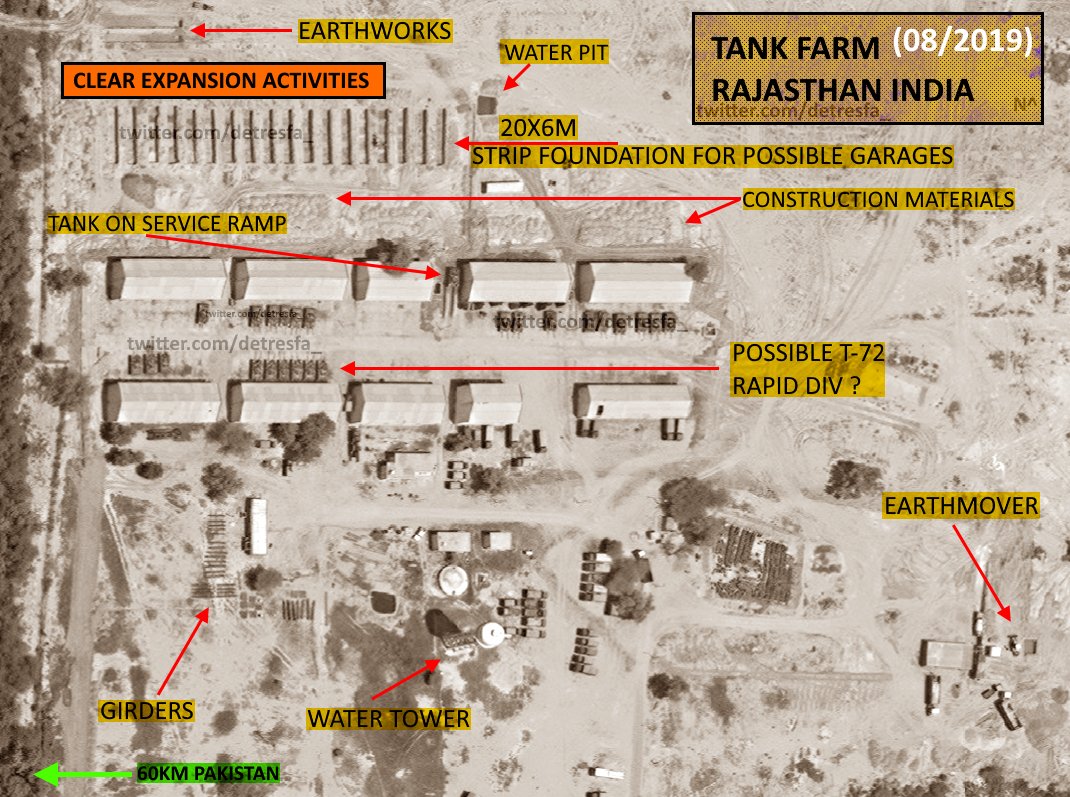
Since they are deployed along the border, these IBGs will have to be on constant alert and be able to quickly mobilize and disperse to escape preemptive strikes. In fact, as an adaptive measure against IBGs, Pakistan has started deploying a number of Nasr short range missile systems along the border. These Nasr missiles can carry both conventional and nuclear warheads. While these missiles will be effective against large, massed armored formations in a full scale war, IBGs are much smaller in size and also likely to operate in a dispersed manner, which could make strikes by these missiles less effective against them.
In addition to these tactics by IBGs, the facilities where these missiles are based could also be preemptively targeted before they are able to mobilize and disperse. The satellite image below shows one such facility near Bhawalpur, about 90 km from Indian border. But its not clear which platforms this particular facility hosts.
As mentioned before, this is the scenario in which the Indian forces are likely to come closest to crossing Pakistan’s nuclear threshold. Lets look at the nature of this threshold and how the Indian operation will attempt to avoid crossing it. Pakistan has deliberately sought to keep its nuclear strategy obscure in order to deter Indian offensive operations.
What further complicates the matters is the fact that Pakistan possesses low yield tactical nuclear weapons which could be seen as less esclatory at least by the international community, if not by India. Pakistan’s policy also envisions using these tactical nuclear weapons on Pakistan’s own teritorry against invading Indian forces, which could also be seen as less esclatory by the international community, and therefore make it easier for Pakistan to justify the use of these weapons.
But Lt Gen Khalid Kidwai, the former Director General of the Strategic Plans Division of Pakistan’s National Nuclear Command Authority, has enunciated the following four scenarios in which Pakistan will use nuclear weapons: (1) India captures a large part of Pakistani territory, especially the green belt (Territorial Threshold), (2) India destroys a large portion of Pakistani military (Military Threshold), (3) India economically strangulates Pakistan (Economic Threshold) and (4) India politically destabilizes Pakistan (Political Threshold).
The Cold Start doctrine of India, as mentioned before, doesn’t envision either capturing a large part of Pakistani territory, destroying a large part of its military, economically strangulating it or politically destabilizing it. Cold Start doctrine simply envisions conducting limited offensive operations, making shallow inroads into Pakistani territory to either capture and hold small bits of territory for use in negotiations, or destroying Pakistani military infrastructure along the border as a punitive measure in response to a provocation.
How well the Cold Start doctrine performs is something we would learn only if a conflict of that proportion actually erupts, which hopefully won’t happen. More importantly, the deployment of IBGs along the border has made it clear to Pakistan that if there is a repeat of an attack like the one on the Indian parliament, the Indian forces this time would be in a far better situation to retaliate promptly. And this will hopefully make the Pakistani state crack down on, or at least restrain the terror groups based there, from planning and conducting similar attacks.
Conclusion
Before India and Pakistan acquired nuclear weapons, India’s military strategy towards Pakistan was geared towards a full scale war. Nuclear weapons on both sides, however, have made a full scale war very unlikely. Since then, India has cultivated a whole spectrum of sub conventional options to respond militarily to Pakistan, like special forces raids, artillery strikes, air/missile strikes, and conducting offensive operations using Integrated Battle Groups to either destroy Pakistani military infrastructure along the border, or capture and hold small bits of territory to have leverage in negotiations.
Each of these options stops short of a full scale conventional war, and is designed keeping in mind the nuclear thresholds enunciated by Pakistan, making it very hard for Pakistan to justify the use of even tactical nuclear weapons. Even the IBGs that would carry out offensive land operations using tanks and APCs are too small and dispersed to justify the use of tactical nuclear weapons.
The 2016 special forces raid, the 2019 Balakot strike, and the generally increased tempo of cross border artillery strikes, shows that the new government that came to power in 2014 intends to aggressively pursue these various options against Pakistan in retaliation to acts of aggression, either by the Pakistani military, or by the non state actors sponsored by it. This is a departure from the defensive stance taken by earlier governments.
Each of these options also has downsides that must be factored in while planning an operation. Special forces raids are seen as the least esclatory option, but also one of the riskiest of all options for the soldiers involved. Artillery strikes are also a less esclatory option, and have indeed been used countless times in retaliation to provocation. But they have comparatively low deterrence, and their short range limits their ability to hit targets far away from the international border or LOC.
Air/missile strikes are able to hit targets deep inside enemy territory, but are also seen as more esclatory. The extensive improvements in the air defense infrastructure of Pakistan makes use of stand off munitions by manned aircraft, and use of UCAVs, necessary, a field in which India is steadily progressing. Pakistan is also extensively improving its ability to conduct retaliatory air strikes against India using stand off munitions.
While India is also extensively improving its air defense infrastructure to counter such airstrikes, like buying air defense systems like S-400, setting up an air defense command, and buying new fighters like the Dassault Rafale, the falling numbers of fighters in the Indian Air Force, which has left India with just 29 squadrons, is a serious problem. Moreover, stand off munitions could allow Pakistani fighters to conduct air strikes without crossing border. And shooting down stand off munitions is more difficult than shooting down fighters. Although, the long range of S-400 and Barak 8 ER missiles could help target the Pakistani fighters even if they are inside Pakistani air space.
Missile strikes, involving missiles like Pranash, Pralay or Brahmos, are easier than air strikes for India, as no pilots have to cross the border and missiles are much harder to shoot down than aircraft. But a missile strike by India will certainly invite a retaliatory missile strike by Pakistan. And India will find it just as hard to counter such a missile strike. India has been making significant advances in missile defense, with multiple platforms like PAD, AAD, Barak 8, and S-400 capable of shooting down ballistic and cruise missiles, something that Pakistan doesn’t have.
Nonetheless, missile defense is far harder than air defense, and these missile defense systems cannot be solely relied upon. Its likely that to defend against a Pakistani missile strike, Indian forces will have to be dispersed in advance, before India conducts its own missile strike. Dispersing forces will make a Pakistani missile strike much less effective even if it penetrates the Indian missile defenses. But large scale dispersion of forces is expensive and time consuming, and certain instillations, like vital bridges, will still be vulnerable.
A limited land campaign using Integrated Battle Groups as per the Cold Start doctrine is seen as the most esclatory option, coming the closest of all the available sub conventional options to crossing the nuclear threshold of Pakistan. But it will also be seen as the most punitive of all the options.
Even if Pakistan can’t justify using tactical nuclear weapons in response to this option, because of the small size and dispersed nature of IBGs, and the generally small scale of such an operation, the IBGs will still be very vulnerable to the Pakistani artillery. However, the small size of IBGs, the dispersed nature of their operations, and constant mobility, will likely make it relatively difficult for the Pakistani artillery to target them.
Ultimately, it remains to be seen what changes this new stance by India will bring about in Pakistan’s approach to India focused terror groups based on its soil, and in many cases, sponsored by its Army. This will depend a lot on the internal politics in Pakistan, as well as on the state of Pakistan’s economy. Pakistan’s civilian leadership has traditionally been more inclined towards clamping down on terror groups than the Pakistan Army. The power dynamics between these two centers of power in Pakistan, therefore, will play a large role in Pakistan’s response.
Pakistan’s economic situation also needs to improve in order for the terror infrastructure to suffer. This is because economic deprivation, poverty, and unemployment are a major source of frustration among Pakistani youth, which makes them easy to be radicalized and recruited by terror groups.
To put it simply, if a Pakistani youth has an opportunity to live a socially, economically and emotionally fulfilling life due to easily available and well paying jobs, he is far less likely to be tempted to join a terror group out of frustration and lack of purpose in life. This is why the unemployment levels and per capita GDP of Pakistan will also play a large role in deciding the fate of the terror industry running on its soil.


